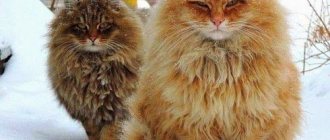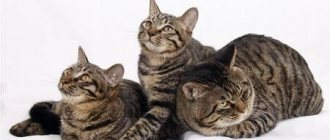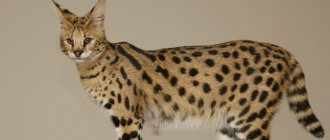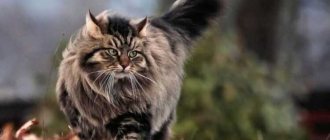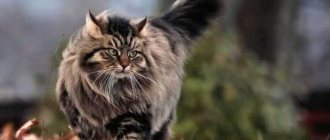History of the origin of the breed
There are many rumors and myths surrounding the origin of the Siberian cat breed. According to some sources, Siberian cats appeared in the Siberian taiga, due to which they have some features of their appearance that helped them survive in difficult climatic conditions.
The Siberian cat is a native long-haired breed and owes its characteristics (appearance, character and endurance) to nature. It is believed that the ancestors of this cat were wild steppe (forest) Siberian cats - predators who are excellent hunters.
The standard for a Siberian cat was determined not so long ago - in the early 90s. Breeders have identified special features of how to identify the breed. They studied what a Siberian cat should be like and gave a detailed description: what it looks like, what its characteristic features are, what its character is and what other features it has.
Read how to care for kittens.
History of the breed
There are at least two versions regarding the origin of Siberian cats. There is an opinion that Siberians appeared as a result of mass crossings of some wild taiga cats with domestic cats. According to the second version, the distant ancestors of the Siberian cat came to these lands from the East along with numerous caravans of merchants who were forced to carry fighting cats with them in order to protect their property from hordes of mice and rats.
The Siberian cat has an impressive appearance
The “merchant” offspring remained in Siberia, and then the forces of natural selection came into play - in harsh natural conditions, a special psycho-phenotype of the Siberian cat was gradually formed, a truly unique animal in many of its qualities. Felinologists agree that the origin of the breed can be dated around the end of the sixteenth century.
For a long time these cats were called Bukhara, then for some reason Moscow, and only relatively recently did they receive their current name. They have repeatedly become heroes of Russian folk tales and literary works - for example, the well-known Scientist Cat from Alexander Pushkin is clearly of Siberian origin.
The black Siberian cat is a character in many fairy tales and mystical stories.
People's cat of Russia
One way or another, in large areas of the Urals and Trans-Urals a fairly large population of interesting animals developed, on the basis of which breed selection subsequently took place. From Siberia, charismatic cats began their victorious march across the Eurasian continent, and then across others.
Thanks to the consistent actions of enthusiasts and systematic breeding work, the Siberian cat has received well-deserved recognition throughout the world. At the end of the eighties of the last century, Moscow, Leningrad and Riga nurseries made a great contribution to the formation of the breed. In the Kotofey club in 1987, its first standard was created, which has since undergone some changes, and five years later the World Organization of Cat Fanciers included the breed in its official lists.
Siberian cats are well adapted to harsh climates
The popularity of Siberian cats among the people was incredibly high, especially given the recent shortage of all other cat breeds. Luxurious fluffy beauties walked proudly through courtyards and streets, delighted their owners, caught mice, gave birth to kittens “out of love,” and no one really thought about such concepts as the gene pool and purity of the breed. Although, perhaps, such democracy has benefited her - fresh blood is still pouring into the breed.
Interestingly, the breed remains open to this day. Any foundling phenotypically similar to a Siberian can receive a certificate of belonging to the breed - a registered pedigree - if it is awarded a club referral to an exhibition and earns at least two “excellent” ratings there. There are very real stories of cats picked up in a trash heap who became titled producers, and a cat of the same street origin named Mars even received the title of World Champion.
Breed standard (appearance):
The first way the Siberian cat differs from others is its size and weight. A powerful, stocky body with fairly well-developed muscles makes these cats majestic. Muscle mass in Siberian kittens takes a long time to form, like in humans, up to 3 years.
The front legs are slightly shorter than the hind legs, which makes the cat's spine slightly sloping (this is what gives the animal strength and agility). The average weight of an adult Siberian cat is 6 kilograms, a male cat is 12 kg.
“Siberians” have large, muscular paws, which distinguish them from other cats by the fact that there are quite long tufts of hair between their toes.
The long hair of the Siberian kitten is hypoallergenic, which makes this cat an indispensable pet for people with allergies. The coat of cats of this breed consists of two layers: a very thick undercoat and a hard coat that practically does not get wet. Thanks to this “coat”, cats feel comfortable in all weather conditions and temperatures. The head of a cat of this breed is quite large, round in shape, and the neck is short but strong. The muzzle has a trapezoidal shape. On their ears you can see tassels inherited from their ancestors.
The eyes are oval in shape, medium in size and slightly slanted.
The color of a Siberian cat can be completely different, as evidenced by the pictures (photos) that you will see below.
Breeding work
The global popularity of the Siberian cat is growing, and breeding nurseries, engaged in breeding, are moving towards improving the breed. The so-called traditional colors and the Neva masquerade cat (Siberian colorpoint) have recently become the most popular - many breeders specialize in these varieties of Siberians.
Neva Masquerade - the fruit of love between Siberian and Siamese cats
The Neva Masquerade cat is a young independent breed created on the basis of the Siberian cat; it combines all six varieties of point colors, which are unacceptable according to the Siberian breed standard. Initially, these blue-eyed fluffy cats appeared as a result of the hybridization of Siberian and Siamese breeds, but in many respects they are still classified as Siberians.
Breeding Features
Siberian cats are endowed with very strong genetics and an amazing ability to reproduce. They are prolific - one litter can have from five to ten kittens, which almost never happens in other breeds. Male Siberians do not lose their reproductive qualities until they are eleven or twelve years old, and females do not lose their reproductive qualities until they are eighteen years old. Of course, at this age, owners should not allow offspring to appear - this is too difficult for an elderly animal.
Siberian cats retain reproductive abilities into old age
The selection of healthy sires with good heredity plays a primary role in breeding work. In addition, for breeding Siberian cats it is very important to navigate the genetics of colors, which are so richly represented in this breed.
Table: possible colors of Siberian kittens in the litter
| Cat | Cat | Kittens-cats | Kitten cats |
| Black | Black | Black Blue | Black Blue |
| Blue | Black Blue | Black Blue | |
| Red | Red Cream | Tortoiseshell Blue-cream | |
| Tortoiseshell Blue-cream | Cream | Red Cream | |
| Tortoiseshell | Black Blue Red Cream | Black Blue Tortoise Blue-cream | |
| Blue-cream | Black Blue Red Cream | Black Blue Tortoise Blue-cream | |
| Blue | Black | Black Blue | Black Blue |
| Blue | Blue | Blue | |
| Red | Red Cream | Tortoiseshell Blue-cream | |
| Cream | Cream | Blue-cream | |
| Tortoiseshell | Black Blue Red Cream | Black Blue Tortoise Blue-cream | |
| Blue-cream | Blue Cream | Blue Blue-cream | |
| Red | Black | Black Blue | Tortoiseshell Blue-cream |
| Blue | Black Blue | Tortoiseshell Blue-cream | |
| Red | Red cream | Red Cream | |
| Cream | Red cream | Red Cream | |
| Tortoiseshell | Black Blue Red Cream | Red Cream Tortoise Blue Cream | |
| Blue-cream | Black Blue Red Cream | Red Cream Tortoise Blue Cream | |
| Cream | Black | Black Blue | Tortoiseshell Blue-cream |
| Blue | Blue | Blue-cream | |
| Red | Red cream | Red Cream | |
| Cream | Cream | Cream | |
| Tortoiseshell | Black Blue Red Cream | Red Cream Tortoise Blue Cream | |
| Blue-cream | Blue Cream | Cream Blue-cream |
The genetics of colors are not random accidents
In what cases is sterilization necessary?
The main argument for sterilizing an animal can only be medical indications when it comes to its health or even life. Also, sterilization or castration may become a condition of the breeder when selling a kitten, which he does not consider possible to allow for breeding. It is also impossible to obtain offspring from overly aggressive animals - in such cases, sterilization usually reduces the level of hostility.
All other situations must be carefully analyzed to determine the advisability of the operation - surgery is performed under general anesthesia and can be fraught with serious complications.
Character and some features
The origin of the cat makes itself felt. The Siberian cat is an excellent hunter. Her hunter's instinct is so developed that she will not disappear in any “extreme” conditions. She will dexterously catch not only a mouse, but also a rabbit. This same hunting instinct makes a cat similar to a dog. She (happily) brings things in her teeth. Based on this data, you will know how to name and choose a name for a kitten, a selection of beautiful nicknames.
Fearlessness. “Siberians” protect their space, do not allow outside animals and people in, informing their owners that “strangers” have arrived. They are not at all afraid of dogs, people, or anything that scares ordinary cats (sharp noise, the hum of cars, sirens...).
Learning ability. The Siberian cat is smart and obedient. She can be trained to a certain place for the toilet.
Intelligence, prudence. A cat will never climb anywhere without making sure that it is safe. Before getting a toy out from under a chair (wardrobe, bed), she will think carefully about how to do this.
Siberian cats are not picky. These cats will play with any object (toy, paper, thread...) that is offered to them. Passion for heights. Don't be surprised to see a cat on a refrigerator, cabinet or high up in a tree, as this is completely normal for them.
Restraint towards people. Siberian cats are affectionate, but reserved. They will not constantly ask to be held, but they will never leave their owner when he is ill (sick, upset about something). They will not adapt to their owners, since they themselves consider themselves such. A Siberian cat will be friends with its owner only if the owner respects him.
Health and immunity are much stronger than those of their counterparts. Life expectancy is on average 15-20 years.
Offspring. Siberian cats can give birth to 5-9 (rarely) kittens. The reproductive age of a cat can last up to 18 years, a cat - only up to 11.
Breed defects
Despite its long history, the Siberian cat breed has not yet been fully formed. Sometimes genes can develop in such a way that the offspring will have problems with both phenotype and health. If in the first case the defects are regarded as a breed defect and do not at all interfere with the normal life of the cat, then hereditary diseases should be a signal to the breeder that it is advisable not to allow this line of sires into breeding.
Major diseases
The peculiarities of the formation of the breed generally had a positive effect on the health of its representatives. Having gone through a long stage of natural selection in the harsh climatic conditions of Siberia, these cats have learned to perfectly resist many diseases. The famous Siberian health is fully inherent in them, which is one of the undoubted advantages of this breed. If well maintained, a Siberian can live twenty years or even more.
Typically, Siberian cats have good health, but pathologies are possible
Among the hereditary diseases to which these animals are predisposed is hypertrophic cardiomyopathy, a severe but fortunately rare heart disease that usually ends in death.
Siberian cats by nature are textured, powerful animals; A strong, well-formed bone structure is especially important for them. Improper cultivation, regular overeating and lack of sufficient exercise can lead to the development of musculoskeletal problems. Like all heavy individuals, Siberians have risks of dysplasia and other joint diseases, especially in old age.
In recent years, such illnesses have been provoked by unscrupulous breeding work. Some, by hook or by crook, try to get overly large animals that look impressive and are expensive. Unfortunately, few people realize that high-quality cultivation of such giants is not only very difficult and expensive, but is also fraught with many health problems.
Pedigree marriage and disadvantages
A disadvantage of the breed is considered to be a straight profile - ideally, the transition on the muzzle from forehead to nose should be very smooth. The massive rounded head of the Siberian cat is generally the subject of close and meticulous attention of experts who, acting in accordance with the standard, can find a number of disadvantages here:
- too short or, conversely, long lightweight muzzle;
- flat cheeks;
- high cheekbones;
- weak chin;
- small, round or deep-set eyes;
- large or small, incorrectly set or too furry ears.
Breed defects are “written” on the cat’s face
Also a serious drawback can be considered a square or overly stretched body format, its lightness and grace. Elegance and grace - this is definitely not what is said about the Siberian. He walks, leaning heavily on his strong paws, which should not be thin or high. Special requirements apply to the tail: the more luxurious it is, the better. A bald or short, expressionless tail is a definite breed defect and a personal disgrace for a Siberian cat.
Care and maintenance
- Cats can take care of their fur on their own, so their owners only need to comb it occasionally: during the molting period (about 10 days) and constantly (1-2 times a month is enough).
- If we talk about nutrition, feeding these cats is not difficult. The fact is that this breed has a genetically programmed program for natural and varied food, which makes it easier to choose feed and food products for them. There is only one feature that is important to consider when feeding Siberian breeds - the amount of protein (during growth). Considering the fact that a kitten’s muscles are formed by the age of 3, its nutrition during these years should be predominantly protein (about 70%).
- Do not forget about their love of freedom and periodically release them into the wild.
Video
Proper nutrition and health
Since this cat grows for a long time - up to five years, its diet should be properly balanced and rich in protein. In urban environments, it is advisable to use super-premium dry food with a daily treat in the form of raw chicken meat - heads and necks are suitable.
To avoid the risk of your pet getting intestinal infections, meat should be thoroughly frozen and washed with running water.
Until the age of six months, the kitten is fed five times a day, then transferred to two meals a day.
Cats of this breed were formed as a result of long natural mutations, naturally. Therefore, they do not have genetic or other species-specific diseases.
The few cases of congenital defects in appearance are explained either by a mismatch of parental genotypes or by random factors.
A good appetite, especially in urban conditions, when the cat lacks physical activity, sometimes leads to obesity. You should carefully monitor your pet's diet.
Otherwise, the requirements for maintaining your pet’s health are the same as for other breeds:
- deworming for helminths every three months;
- timely treatment for external parasites, especially important for walking cats;
- Vaccinate annually against rabies and known viral infections.
Photos of Siberian cats
If you don’t want to waste time loading stories, you can look at the photographs of the Siberian cat, which show various color options:
- blue
- Neva Masquerade
- red (which has a golden tint)
- white
- silver
- black
- tricolor
- tortoiseshell
Conclusions about the breed
The Siberian soul hides in the powerful body of a Siberian cat. The friendly and open creature has retained many of the habits of its ancestors - a love of hunting and natural observation. There are legends about the intelligence of these cats - Siberians do not need to be taught tricks and miracles of training, they themselves, by observing people, begin to understand what they want from them.
The Siberian cat is a wonderful companion who knows how to maintain self-esteem. They have a very developed sense of home and in this quality Siberians are close to dogs. Fearlessness is also their trait. What scares an ordinary cat will only amuse a Siberian cat. Siberian cats are silent and you won’t get any unnecessary sounds from them.
The Siberian cat has no hereditary diseases.
Reviews from Siberian cat owners
Konstantin : “A stuffed animal weighing 9 kilograms – that’s all about our Masik. The cat we got was extremely friendly. Despite the fact that we took him in as an adult, Masik somehow quickly adapted to our family and today the family can no longer imagine itself without this Siberian. Masik is kind and playful - when he is bored, he finds a mouse toy hidden somewhere, brings it into the room and moves his paw with a tender expression on his face. He has become a dad more than once and I must say that all the children adopted his best qualities.”
Albina : “We raise our Siberian cat from a young age - when we adopted the kitten, he was only a month and a half old. Then it was a scratchy ball of fur and nothing has changed in three years. Unfortunately, our cat never learned to play without claws and we all walk around with scratches all year round. The Siberian cat is vengeful and does not forgive even accidental insults. If you accidentally hit a cat, then rest assured that in about 15 minutes he will jump out at you from around the corner with his claws at the ready. But he sleeps so beautifully with his belly up - for this sight we forgive him all his shortcomings! "
Gleb : “Lexus requires special tuning. Lexus is my cat, which requires only the most expensive sausage, only fresh meat and only collective farm sour cream. For these riches, he is ready to pay me back, firstly, with vigorous runs around the apartment at 5 o’clock in the morning, and secondly, with a sofa wonderfully tousled by his claws. Despite its size, Lexus is cowardly, cunning and at the same time very charming. He is friends with me and my son, tolerates his wife and mother-in-law - a real man!”
Table: pros and cons of the Siberian breed
| Breed Features | pros | Minuses |
| Character | Calm and balanced | Sometimes vindictive, vindictive and aggressive |
| Content | Easy to maintain and care | Requires regular brushing and walking |
| Nutrition | Can eat both ready-made food and natural food | Tends to overeat and is picky about food |
| Health | High resistance to diseases | Predisposition to joint pathologies |
Where to buy a Siberian kitten?
You can buy Siberian kittens at a nursery or from a breeder. The cost of a kitten is influenced by many factors (pedigree, color and other features). The lowest price for a purebred Siberian cat will be about 5 thousand rubles (1,200 UAH), the maximum cost can reach 20 thousand rubles (8,000 UAH).
Where to buy a Siberian kitten? We invite you to pay attention to the following nurseries, the reviews of which are only positive:
- Cattery of Siberian cats “Dauria” (https://www.dauriacats.ru/about.html) and nursery “Gloria” in Russia, Moscow.
- Nursery “Girasole” (https://girasole.by) in Belarus, Minsk.
- Nursery “Zaimka” (https://zaimka.com.ua/) in Kyiv.
Choose a fluffy kitten from any nursery or breeder and you will not regret having a Siberian cat as your friend.
At what age can you take a Siberian cat kitten to a new home?
- Ancient dog breeds
- Dog's sense of smell
- Maine Coon
- Domestic iguana
- How much does a raccoon cost?
- Interesting facts about cats
Siberian cats can be transported to a new owner's home only when they are three months or more old. Until this age, kittens urgently need to communicate with their mother and feed her very healthy milk. Being near her, young Siberians learn useful skills, including eating solid food, lapping, using a tray, scratching post, and communicating with other cats and people. Also, before the third month of life, primary vaccination, sterilization or castration are completed, which new owners will not have to think about. Raising small kittens without experience is always dangerous for the life of the animal. Many breeders prefer to pass on high class Siberians at the age of 4 months.

